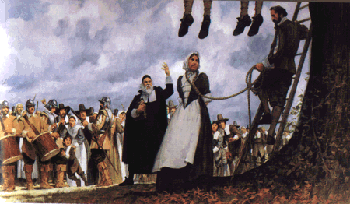
Stacy Schiff, a Pulitzer-Prize winning author of books on historical topics like the Salem Witch Trial and Benjamin Franklin, argues that in fact it's both:
"[W]hile the demonizing may sound un-American, it happens also to be ur-American."Her word-choice here (ur-American means "earliest" or "original") previews Schiff's thesis that a fear of threats to national security was always a part of the American identity. She mines examples from the first European settlers and colonists to prove that thesis.
A long list of "[c]onspiratorial fantasies" concerning Quakers, Baptists, Irish Roman Catholics, and Native Americans were among those demonized by 17th-century Massachusetts Puritans, she writes. Schiff draws a straight line from those early perceived threats to later actions against Mormons, Japanese internment, and today's "rhetorical fireballs" against Islam and Muslims.
 |
| Two Quakers Hung, but Mary Dryer is Freed, Boston, 1658 http://www.webpages.uidaho.edu/ngier/Quakers.htm |
The article -- just 12 paragraphs long -- would be a great source for a first activity once we return from winter break in January.
Warm-up: Ask students to define "xenophobia." Then ask if they know of examples of xenophobia that specifically affected them or their family/friends, and if they have read/heard about examples of xenophobia occurring currently elsewhere in the world. Then,
- Ask students to brainstorm examples of xenophobia we have studied so far this year. (Examples could include the Alien Act under President John Adams and the American/Know-Nothing Party during the antebellum era.)
- Poll the class (using hands, or by voting with their cell phones on either socrative or poll everywhere) on this question: Which is the real "American" value: Toleration or xenophobia?
- Have students read Schiff's essay and underline each example of intolerance. They should research each one, then plot each example on a timeline.
- Poll the class a second time, asking the same question. Lead a discussion: Did anyone change her/his vote, and why?
- Conclusion: Students write a paragraph reflecting on the activity (describing their initial vote; summarizing Schiff's argument; and explaining whether their opinion changed as a result of the reading and/or class discussion).
Personal note:
This is my first post!
Thanks to Ken Halla for inviting me to join these blogs. I've been a fan of his pioneering work integrating technology into classrooms for years, and I was honored when he asked me to contribute. You'll also see me posting to his US Government Teachers blog.
Thanks also to George Coe, a friend and admired colleague, for first sending me the link to this article.
No comments:
Post a Comment